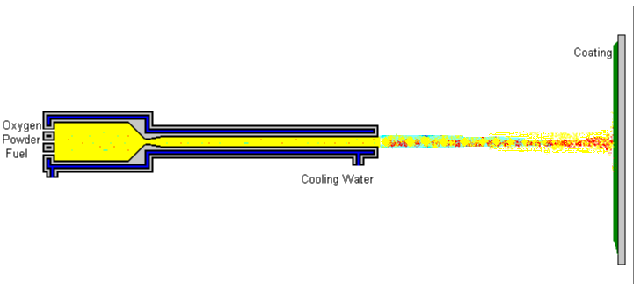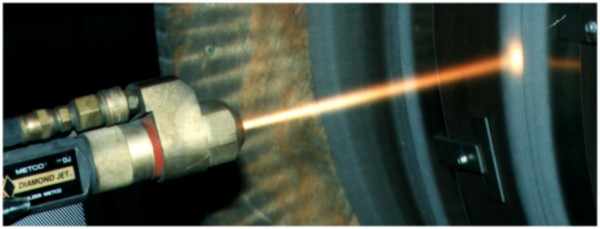HVOF
High Velocity Oxygen Fuel Thermal Spray Process


The HVOF (High Velocity Oxygen Fuel) Thermal Spray Process is
basically the same as the combustion powder spray process (LVOF) except
that this process has been developed to produce extremely high spray
velocity. There are a number of HVOF guns which use different methods
to achieve high velocity spraying. One method is basically a high
pressure water cooled HVOF combustion chamber and long nozzle. Fuel
(kerosene, acetylene, propylene and hydrogen) and oxygen are fed into
the chamber, combustion produces a hot high pressure flame which is
forced down a nozzle increasing its velocity. Powder may be fed axially
into the HVOF combustion chamber under high pressure or fed through the
side of laval type nozzle where the pressure is lower. Another method
uses a simpler system of a high pressure combustion nozzle and air cap.
Fuel gas (propane, propylene or hydrogen) and oxygen are supplied at
high pressure, combustion occurs outside the nozzle but within an air
cap supplied with compressed air. The compressed air pinches and
accelerates the flame and acts as a coolant for the HVOF gun. Powder is
fed at high pressure axially from the centre of the nozzle.

The coatings produced by HVOF are similar to those produce by the
detonation process. HVOF coatings are very dense, strong and show low
residual tensile stress or in some cases compressive stress, which
enable very much thicker coatings to be applied than previously
possible with the other processes.
The very high kinetic energy of particles striking the substrate
surface do not require the particles to be fully molten to form high
quality HVOF coatings. This is certainly an advantage for the carbide
cermet type coatings and is where this process really excels.
HVOF coatings are used in applications requiring the highest density and strength not found in most other thermal spray processes. New applications, previously not suitable for thermal spray coatings are becoming viable.

Introducing
Nature of Thermal Spray Coatings
Surface Engineering in a Nutshell
Surface Engineering Forum
Thermal Spray Gun Repair Service
Plasma Consumable Parts
Thermal Spray Powder Supplies
Applications:
Thermal Spray Coatings on Carbon and Glass Fibre Reinforced Polymers
HVOF Coating of Paper Making Roll
Abradable Coatings
Thermal Spray Processes:
Combustion Wire Thermal Spray Process
Combustion Powder Thermal Spray Process
Arc Wire Thermal Spray Process
Plasma Thermal Spray Process
HVOF Thermal Spray Process
HVAF Thermal Spray Process
Detonation Thermal Spray Process
Plasma Flame Theory
Cold Spray Coating Process
Wear and Use of Thermal Spray Coatings
Corrosion and Use of Thermal Spray Coatings
Glossary of Thermal Spray and Surface Engineering Terms
Image Directory for Thermal Spray Coatings
Plasma Gas Flow Information
Plasma Gas Flow Correction Calculator
Contact Form
Links to other interesting sites related to thermal spray and surface engineering
Reciprocal Links
Periodic Table of the Elements
SI Units
Calculators for Conversion between Units of Measurement
Hardness Testing
Surface Engineering Message Board Archive
Surface Engineering Message Board Archive Index
Photography Gallery
Photography Gallery3
© Copyright Gordon England